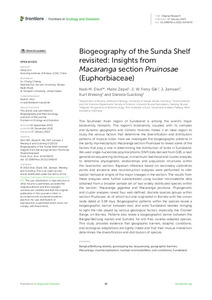| dc.date.accessioned | 2023-02-24T14:55:11Z | |
| dc.date.available | 2023-02-24T14:55:11Z | |
| dc.date.issued | 2023-01-17 | |
| dc.identifier | doi:10.17170/kobra-202302217522 | |
| dc.identifier.uri | http://hdl.handle.net/123456789/14447 | |
| dc.description.sponsorship | Gefördert durch den Publikationsfonds der Universität Kassel | ger |
| dc.language.iso | eng | eng |
| dc.rights | Namensnennung 4.0 International | * |
| dc.rights.uri | http://creativecommons.org/licenses/by/4.0/ | * |
| dc.subject | Bangka/Belitung islands | eng |
| dc.subject | genotyping-by-sequencing | eng |
| dc.subject | geographic barriers | eng |
| dc.subject | Macaranga | eng |
| dc.subject | myrmecophytism | eng |
| dc.subject | nuclear microsatellites | eng |
| dc.subject | soil conditions | eng |
| dc.subject | Sundaland | eng |
| dc.subject.ddc | 570 | |
| dc.subject.ddc | 580 | |
| dc.title | Biogeography of the Sunda Shelf revisited: Insights from Macaranga section Pruinosae (Euphorbiaceae) | eng |
| dc.type | Aufsatz | |
| dcterms.abstract | The Southeast Asian region of Sundaland is among the world’s major biodiversity hotspots. The region’s biodiversity coupled with its complex and dynamic geographic and climatic histories makes it an ideal region to study the various factors that determine the diversification and distribution patterns of tropical biota. Here we investigate the biogeographic patterns in the partly myrmecophytic Macaranga section Pruinosae to reveal some of the factors that play a role in determining the distribution of biota in Sundaland. We used single nucleotide polymorphisms (SNP) data derived from GBS, a next generation sequencing technique, in maximum likelihood and cluster analyses to determine phylogenetic relationships and population structures within this taxonomic section. Bayesian inference based on secondary calibration points and ancestral area reconstruction analyses were performed to infer spatial–temporal origins of the major lineages in the section. The results from these analyses were further substantiated using nuclear microsatellite data obtained from a broader sample set of two widely distributed species within the section: Macaranga gigantea and Macaranga pruinosa. Phylogenetic and cluster analyses reveal four well-defined, discrete species groups within section Pruinosae, all of which but one originated in Borneo with the crown node dated at 3.58 mya. Biogeographic patterns within the species reveal a biogeographic barrier between east and west Sundaland besides bringing to light the role played by various geological factors, especially the Crocker Range, on Borneo. Patterns also reveal a biogeographic barrier between the Bangka/Belitung islands and Sumatra for ant-free, swamp-adapted species. This study provides evidence that geographic barriers, edaphic conditions, and ecological adaptations are tightly linked and that their mutual interaction determines the diversification and distribution of species. | eng |
| dcterms.accessRights | open access | |
| dcterms.creator | Dixit, Nadi Manjunath | |
| dcterms.creator | Zirpel, Malte | |
| dcterms.creator | Slik, Johan Willem Ferry | |
| dcterms.creator | Jamsari, J. | |
| dcterms.creator | Weising, Kurt | |
| dcterms.creator | Guicking, Daniela | |
| dc.relation.doi | doi:10.3389/fevo.2022.1049243 | |
| dc.subject.swd | Sundaschelf | ger |
| dc.subject.swd | Bangka-Belitung | ger |
| dc.subject.swd | Wolfsmilchgewächse | ger |
| dc.subject.swd | Macaranga | ger |
| dc.subject.swd | Genotypisierung | ger |
| dc.subject.swd | Biodiversität | ger |
| dc.subject.swd | Satelliten-DNS | ger |
| dc.subject.swd | Bodenchemie | ger |
| dc.type.version | publishedVersion | |
| dcterms.source.identifier | eissn:2296-701X | |
| dcterms.source.journal | Frontiers in Ecology and Evolution | eng |
| dcterms.source.volume | Volume 10 | |
| kup.iskup | false | |
| dcterms.source.articlenumber | 1049243 | |


